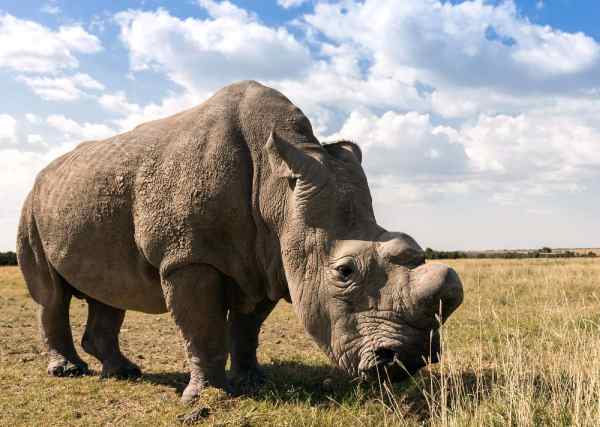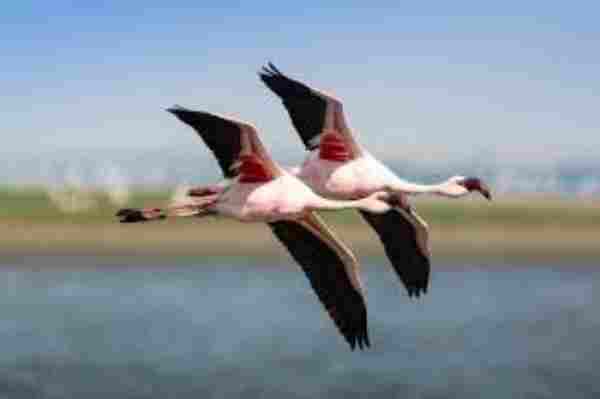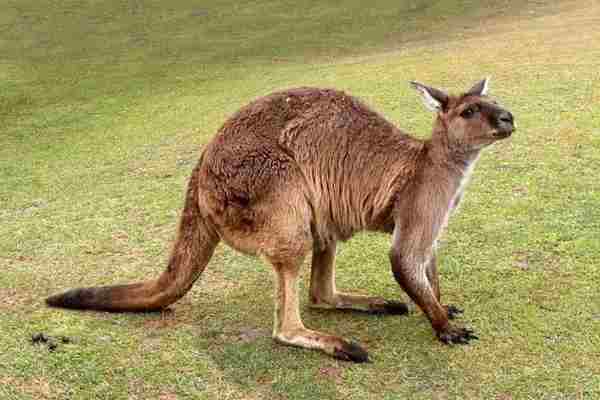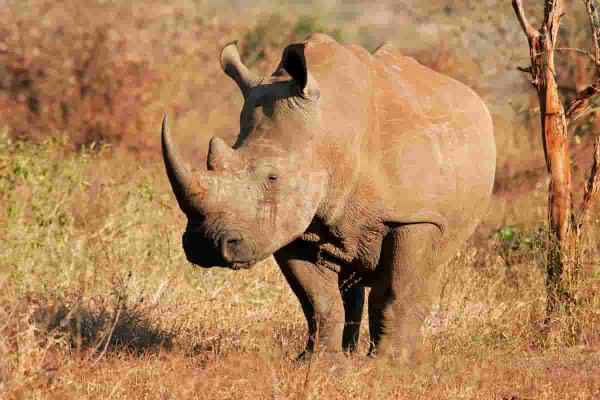Animals come in all shapes and sizes, and it’s fascinating to explore the many different species that inhabit our planet. If you’ve ever wondered what animals have names ending with the letter “o,” you’re in luck – there are quite a few!
Table of Contents
From the humble armadillo to the majestic buffalo, there are 13 animals that you might not have realized share this feature.
And, each of these creatures has its own unique characteristics that make it stand out from the crowd. So, if you’re ready to learn more about some of the world’s most interesting animals, let’s dive in and discover the mysteries of the animal kingdom together!
List of Animals That End with O
Rhino

Scientific Name: Rhinocerotidae
Type of Animal: Mammal
Diet: Herbivore
Lifespan: 35 – 50 years
Rhinos are fascinating creatures with a limited population in the world today. Only five species of these massive animals remain, including the black and white rhinos from Africa, and the greater one-horned, Sumatran, and Javan rhinos from Asia. One of the ways they communicate with one another is through a variety of noises like trumpeting, snorting, sneezing, and even screaming.
These sounds serve as their language and help them communicate vital information about their surroundings. Rhinos are also herbivores, feeding mainly on grass and shrubs. Interestingly, rhinos enjoy taking mud baths because it not only helps them cool off in hot weather but also acts as a natural sunscreen protecting their thick skin. It’s a wonder how these gentle giants have managed to survive given their dwindling numbers.
Buffalo

Scientific Name: Bubalus bubalis
Type of Animal: Mammal
Diet: Herbivore
Lifespan: 10 – 20 years
The African buffalo is an impressive herbivore that roams the grasslands, savannahs, and rainforests of eastern and southern Africa. As one of the largest land animals on the continent, it consumes vast amounts of grass and other plant matter every day.
Of the four known subspecies, the Cape buffalo is the most common and is often found close to a reliable source of water. These majestic creatures travel in herds, grazing at a leisurely pace as they satisfy their hunger.
Whether you’re exploring the vast savannah or traversing dense rainforest, there’s a good chance you’ll spot one of these magnificent beasts stretching its limbs and enjoying the African sun.
Flamingo

Scientific Name: Phoenicopterus
Type of Animal: Bird
Diet: Omnivore
Lifespan: 20 – 30 years
Flamingos are fascinating creatures that are known for their striking pink colour. These birds commonly live in large flocks, both in the water and the air. During breeding seasons, the lesser flamingo can be found in African lakes where both males and females interact with one another. Meanwhile, the greater flamingo can be found in large numbers in Atlantic and tropical America.
Flamingos feed on algae, diatoms, and some invertebrates like molluscs. Interestingly, the pink colour of the bird originates from its food containing pigments of carotenoids. Despite their peculiar appearance, it is clear that flamingos are a remarkable species that continue to captivate us with their unique qualities.
Dodo

Scientific Name: Raphus cucullatus
Type of Animal: Bird
Diet: Omnivore
Lifespan: 10 – 30 years
It is a sad reality that the dodo bird, an interesting creature once found on the island of Mauritius, is now extinct. This species of bird was originally discovered in the 1500s and was unfortunately hunted to extinction by humans by around 1681.
The dodo was an impressive bird, weighing in at approximately 50 pounds and larger than a turkey. Despite their size, they were flightless and had small heads along with short, yet heavy bills.
Regrettably, the only surviving remains of the dodo are a foot and head that were discovered in Oxford. It’s a sobering reminder of just how fragile some of our planet’s most unique wildlife can be.
Gecko

Scientific Name: Gekkonidae
Type of Animal: Reptile
Diet: Carnivore
Lifespan: 10 – 20 years
These tiny nocturnal reptiles are fascinating creatures with unique adaptations. Measuring between two and six inches, they may be small, but their well-formed limbs and soft skin make them stand out in the reptile world. Their habitats range from forests to jungles to human homes, making them adaptable to various environments.
What really sets them apart, however, is their ability to climb and sprint on water. Their modified feet have small hook-like features that allow them to attach to surfaces and propel themselves forward, making them incredibly nimble. This adaptation also allows them to escape predators by sprinting across water without the risk of sinking. Overall, these small reptiles are impressive creatures with remarkable abilities.
Armadillo
Scientific Name: Dasypodidae
Type of Animal: Mammal
Diet: Omnivore
Lifespan: 7 – 20 years
Armadillos, with their armour-like appearance, are a familiar sight in Central and South America. These endearing creatures might look like armoured possums, but their shells serve a vital purpose beyond just giving them a distinctive look. Armadillos rely heavily on their protective shells, which they’ve adapted to curl up into a tight ball to evade predators swiftly.
Their scales, crafted from keratin and cleverly overlapped to generate a unique pattern, assure they’re safe from potential hunters. Nevertheless, their defences do not end there, for they are exceptionally talented burrowers, constructing comfortable homes under the ground, lined with leaves for warmth.
Dingo

Scientific Name: Canis lupus dingo
Type of Animal: Mammal
Diet: Carnivore
Lifespan: 7 – 10 years
The dingo, also known as warrigal, is a fascinating wild dog native to Australia. It bears a close resemblance to our beloved domesticated dogs in both appearance and behaviour. In fact, studies have shown that it may have been brought to Australia over 4,600 years ago, making it an ancient breed.
The oldest known dingo fossil dates back to 3,500 years ago, which suggests that the species has survived and thrived for thousands of years. Dingos are known to hunt alone or in small packs of up to 12 dogs.
As carnivores, they may prey on wallabies and kangaroos in the wild. These creatures are a true testament to the wild spirit and tenacity of Australia’s native animal kingdom.
Palomino

Scientific Name: Equus caballus
Type of Animal: Mammal
Diet: Herbivore
Lifespan: 25 – 30 years
The Palomino horse breed is truly a sight to behold with its distinctive golden coat and striking white mane and tail. Originating from the Arabian desert, these horses possess a unique chestnut and crème gene that sets them apart from other horse breeds.
While they may not be commonly seen on the track due to their primary purpose in parades and showcasing, their beauty and elegance make them a prized possession for horse enthusiasts. Whether you’re a seasoned equestrian or simply appreciate the beauty of these majestic creatures, the Palomino horse breed is sure to leave you in awe.
Kangaroo

Scientific Name: Macropodidae
Type of Animal: Mammal
Diet: Herbivore
Lifespan: 8 – 25 years
The vast expanse of the Australian desert is home to the elusive kangaroo, a creature that spends most of its day lounging in the sun and biding its time until nightfall. Once the light starts to fade, these social animals spring into action, hopping and bounding across the dusty terrain in search of food.
As herbivores, they indulge in a varied menu of fruit, flowers, and leaves, quenching their thirst with the occasional lick of their forearms. It’s a clever tactic for staying cool in the scorching desert heat, a trait that helps them survive in this harsh environment. Despite the arid sands that surround them, kangaroos cannot help but be sociable, often forming groups with other individuals.
And what an interesting group they are – ranging from the mighty red kangaroo, standing tall at 5 feet, to the musky-rat kangaroo, a tiny creature that only grows up to 8 inches. With their curious habits and unique features, it’s no wonder kangaroos fascinate and delight us all.
Bonobo

Scientific Name: Pan paniscus
Type of Animal: Mammal
Diet: Omnivore
Lifespan: 40 years (in captivity)
Have you ever heard of the Bonobo? It’s a fascinating species of ape that was once classified as a chimpanzee until 1933. Even though they resemble chimps, they have longer limbs and are much slimmer.
These apes are native to the rainforests in the DRC and are omnivores, meaning they eat a variety of foods such as fruits, roots, and herbs. Bonobos also supplement their diet with worms, squirrels, bats, and caterpillars.
Interestingly, unlike their cousins, the chimps, Bonobos do not eat monkeys. It’s amazing to learn about the diversity of species that inhabit our planet, and the Bonobo is no exception.
Bongo

Scientific Name: Tragelaphus eurycerus
Type of Animal: Mammal
Diet: Herbivore
Lifespan: 9 – 21 years
The bongo is a beautiful animal that belongs to the antelope family. It can be mainly found in the lush forests of the Congo, Kenya, West Africa, and South Sudan. They come in two species, the Mountain and Lowland bongo, both of which boast a reddish-brown coat adorned with white stripes and long horns.
These creatures are herbivores, consuming a lot of leaves, grass, bark, and roots. Primarily feeding at night, they’ve developed an acute sense of hearing and smell to avoid danger. Their habitat preference for living deep in the forests where they can remain hidden from predators, is a testament to their shy and peaceful nature. It’s safe to say that the incredible bongo is a creature of the night and a wonder to behold.
Kakapo

Scientific Name: Strigops habroptilus
Type of Animal: Bird
Diet: Herbivore
Lifespan: 40 – 80 years
The kakapo can be described as an unusual parrot owl native to New Zealand. It is known for its very soft feathers around its body and face.
This bird cannot fly, but it gets around without problems thanks to its strong legs.
Other than being flightless, it doesn’t move when surprised or shocked. Instead, it remains still until the danger passes.
Being herbivores birds, they eat various types of plants.
The kakapo is a rare gem in the world of birds. This unique parrot owl is only found in New Zealand and is often described as unusual. The kakapo’s soft feathers around its face and body set it apart from other birds, and it relies heavily on its strong legs to get around.
Despite being flightless, this bird doesn’t let that stop it from going where it wants to go.
One of the most fascinating things about this bird is its unusual behaviour when it’s surprised or scared. Instead of running away or flying off, the kakapo stays perfectly still until the danger passes.
As a herbivore, it enjoys a variety of plants. It’s no surprise that the kakapo has earned a place in the hearts of New Zealanders and bird enthusiasts all around the world.
Cuckoo

Scientific Name: Cuculidae
Type of Animal: Bird
Diet: Carnivore
Lifespan: 5 – 6 years
The last animal on our list of fascinating creatures that end with o is the cuckoo. These small brown and white birds with their striking yellow lower beaks are simply unforgettable. While mainly found in Western Europe and parts of North America, cuckoos thrive in tropical regions with thick vegetation.
This makes them expert hiders as they dart in and out of trees. As insect feeders, their daily diet consists of various large flying insects. Their unique abilities to blend in with their surroundings and their impressive hunting skills make cuckoos a captivating addition to the animal kingdom.
Final Words
And with that, we come to the end of our compilation featuring 13 remarkable animals that share the common trait of ending with the letter “o.”
We trust that this article has provided both information and enjoyment for your reading pleasure. Armed with these newfound facts, you’ll have some intriguing additions to your knowledge bank for the next time you engage in an animal-themed quiz with your friends.
Reference:
A motivated philosophy graduate and student of wildlife conservation with a deep interest in human-wildlife relationships, including wildlife communication, environmental education, and conservation anthropology. Offers strong interpersonal, research, writing, and creativity skills.










